| Qu1: |
Boiling point is a physical property and is therefore controlled by intermolecular forces. The system with the strongest intermolecular forces will have the highest boiling point. Carboxylic acid (highest MW and strong H bonding), alcohol (H bonding) and alkane (no dipole and therefore the intermolecular forces are that much weaker). (v1= A, v2 =C) |
 |
| Qu 2: |
Basicity...Think about the availability of the electrons in the bases, always a good idea to draw in the lone pairs because lone pairs are more available than bonded pairs. Ammonium salts are not basic (no available electrons). Resonance delocalisation in carboxylates makes the e less availale than in simple alkoxides, hence alkoxides are more basic than carboxylates. (v1= C, v2 = E) |
 |
| Qu 3: |
Assign the formal charges...N with 2 bonds and 2 lone pairs is -1, N with 3 bonds and a single e is +1, and C with 3 bonds and a single e is 0. (v1= AB, v2 = D) |
 |
Qu 4: |
Carboxylic acid > alpha H next to C=O > aldehyde H (v1= AB, v2 = A) |
 |
| Qu 5: |
The more stable radical can the associated with breaking the weaker C-H to form the radical. So since an sp3 C-H is weaker than sp2 C-H, the phenyl radical is the least stable. The benzylic radical is also stablised by resonance. (v1= A, v2 =AB) |
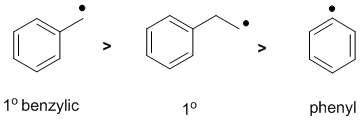 |
| Qu 6: |
Increased branching = increased stability (due to the presence of more stronger primary C-H bonds). (v1= D, v2 =B) |
 |
| Qu 7: |
All are CC bonds. Double bonds are shorter than single due to the higher bond order. The hybridisation of the attached C also affect the bond length... higher s character will result in a smaller hybrid orbital and hence a shorter bond. (v1= AB, v2 = E) |
 |
| Qu 8: |
Each type of H will generate a different monochlorination product. Methylcyclopentane has 4 H types, 1,4-dimethylcyclohexane has 3 and cycloheptane has 1. (v1= A, v2 = AB) |
|
MOLECULAR PROPERTIES:
No real method here, really just do you know various aspects of molecular structure and apply it to the molecule(s) in question. |
| Qu9: |
Primary C-H are stronger than secondary which is stronger than tertiary. Allylic and benzylic postions are further weakened by the adjacent pi system. Therefore, C17-H which is tertiary, allylic and benzylic would be the weakest. (v1= AB, v2 =A) |
| Qu10: |
C19 is secondary (attached to 2 other C atoms) and benzylic (adjacent to a benzene ring). (v1= BE, v2 = BD) |
| Qu11: |
The strongest CC bond will be a double bond where there is no resonance, so the alkene C2=C18. (v1= B, v2 = B) |
| Qu12: |
Assign the R/S stereochemistry, using the Cahn-Ingold-Prelog rules to assign group prioritiesbecause the priorty order of attached groups : C6 (OCC), C17 (CCH), C4 (CHH) and H...and when viewing with the H (low priority away), the sense is clockwise => R (v1= A, v2 = C) |
| Qu13: |
14 : there are 3 rings plus 11 double bonds. (v1= C, v2 = D) |
| Qu14: |
Oxidation states...count the bonds attached to the atom being considered. A bond to a more electronegative atoms counts -1, a bond to the same type of atom counts 0 and a bond to a less electronegative atom (e.g. H) counts +1. Total the count and then consider the formal charge on the central atom since the oxidation state for the central atom plus the groups attached must equal the atoms formal charge. For C2 the C is attached to 2 x C (count 0), 1 x O (count -1) and 1 x N (count -1) therefore total = -2 and therefore the oxidation state C2 = +2. (v1= AC, v2 = C) |
| Qu15: |
There are two carboxylic acid groups in Vitamin B9, the acid group with an adjacent electronegative atom will be more acidic (due to inductive effects). (v1= E, v2 = B) |
| Qu16: |
N3 is in a double bond, thus it is sp2 hybridised and the lone pair is in a hybrid orbital. N19 is in an amide and the lone pair is in a p orbital due to the resonance interaction with the adjacent C=O pi system (v1= D, v2 = B) |
| Qu17: |
Since neutral C atoms don't have lone pairs, then C24 is the least basic. (v1= AC, v2 = E) |
SPECTROSCOPY:
Use the IR spectra provided to get the functional groups that are present in the structures, so look for the key groups : C=O (near 1700 cm-1) , -OH or -NH (above 3000 cm-1), aromatic C=C (two bands 1600-1400 cm-1), C-O (near 1200 cm-1) and triple bonds (near 2200 cm-1).... use the tables as needed. |
| Qu18: |
The IR shows a C=O a little above 1700 cm-1. The IR does not show -OH or -NH, or C=C, or triple bonds, and no real sign of C-O. On closer inspection, the C-H stretches are < 3000 cm-1 indicating sp3 C-H only. This would be consistent with the ketone. (v1 = AE, v2 = AD) |
 |
| Qu19: |
| The IR shows a C=O a little above 1700 cm-1. The IR does not show -OH or -NH, or C=C, or triple bonds, but there is a C-O near 1250 and 1050 cm-1 On closer inspection, the C-H stretches are < 3000 cm-1 indicating sp3 C-H only. This would be consistent with the ester. (v1 = BC, v2 = AE) |
|
|
 |
| Qu20: |
The IR does not show a C=O, -OH or -NH. There looks to be a C=C near 1650 cm-1 and on closer inspection, the C-H stretches above and below 3000 cm-1 indicating both sp3 and sp2 C-H consistent with an alkene (v1 = B, v2 =B) |
 |
| Qu21: |
The IR does not show a C=O, -OH or -NH or C=C. There looks to be a triple bond near 2250 cm-1 but no C-H stretches above 3000 cm-1 indicating the absence of sp C-H of a terminal alkyne, hence the nitrile. (v1 = D, v2 = D) |
 |
| Qu22: |
This IR has few absorptions. It does not show a C=O, -OH or -NH, or C=C, or triple bonds. The only functional group band appears to be a C-O just above 1100 cm-1. The C-H stretches are < 3000 cm-1 indicating sp3 C-H only. The only other major band is the C-O just above 1100 cm-1, so this eliminates just about everything except for the ether (v1 = AB, v2 = AC) |
 |
| Qu23: |
The IR shows a strong and broad OH stretch at 2500-3500 cm-1, and C=O near 1700 cm-1 (look for a carboxylic acid (v1 = CD, v2 = BC) |
 |
NOMENCLATURE:
Two types of questions here, however it is a good idea to use key descriptors like E and Z, R or S, cis or trans, numbering, functional group etc. to help screen the answers before getting too tied up in the words. For the first four, name the compound and then match it to the list, for the last four
use the key descriptors and check each molecule in turn. So this section really depends on the nomenclature rules. |
| Qu24: |
An alkane with the longest chain C8, so an octane. Select the longest chain with more simple substituents... there are 3 substituents, a simple ethyl group and two methyl groups. complex substituent, a 1,1-dimethylethyl group. These need to be numbered 2,3,6. Hence, 3-ethyl-2,6-dimethyloctane (v1= E, v2 = AB) |
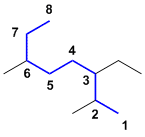 |
| Qu25: |
The longest chain is C8, with an alkene as the principle functional group so an octene. Need to number to give the alkene the lowest number, i.e. -3-ene. We have a methyl and an isopropyl substituent which needs to be numbered as 3,4-. To determine the E/Z we need to prioritise the substituents at each end of the C=C. At the left hand end, the ethyl > H, at the right, the isopropyl (C to CCH) outranks the butyl (C to CHH). This means the higher priority groups the ethyl and the isopropyl are on opposites sides (E). Hence we have E-4-isopropyl-3-methyloct-3-ene. (v1= D, v2= C) |
|
| Qu26: |
The principle functional group is the alkene and those two C atoms need to be 1 and 2. It's a five membered ring (cyclopentene). Then the first point of difference rule requires that the system be numbered as a with the methyl group at C1 rather than C2. This means we have 5-ethyl-1-methylcyclopentene. (v1= AB, v2 = A) |
|
| Qu27: |
The longest chain is C6, with an alkene as the principle functional group so a hexene. Need to number to give the alkene the lowest number, i.e. -3-ene. We have methyl and chloro as substituents which need to be numbered as 3,4- which need to be listed and assigned alphabetically as both are substituents. To determine the cis / trans we need to look at the shape of the parent hydrocarbon chain (i.e. the two ethyl groups) which is trans (opposite side across the C=C). Hence we have trans-3-chloro-4-methylhex-3-ene. (v1 = C, v2 = D) |
|
| Qu28: |
All of the systems are alkyl bromides, it's all about the common alkyl substituents. All the examples are some sort of butyl system. (v1 = B, v2 =C) |
 |
| Qu29: |
Substituted benzenes : nitro and aldehyde.
A nitro group is NO2. NH2 is an amine and CN a cyano or nitrile. meta is the 1,3- arrangement. (v1 =A, v2 = C) |
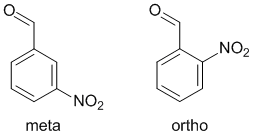 |
| Qu30: |
R/S stereochemistry
Chirality center is marked with a *. Priority of groups there is CHO > CH(CH3)2 > CH3 > H. (v1 =C, v2 = E) |
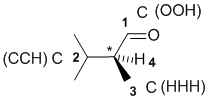 |
| Qu31: |
The bicyclic system has 8C and an alkene so it is an octene. The [3.2.1] indicates the number of C atoms in each link between the bridgehead carbons. Need to start to number from a bridgehead, going along the longer link first to give the alkene the lowest number and hence locate the methyl group. (v1 = E, v2 =C) |
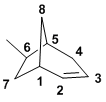 |














